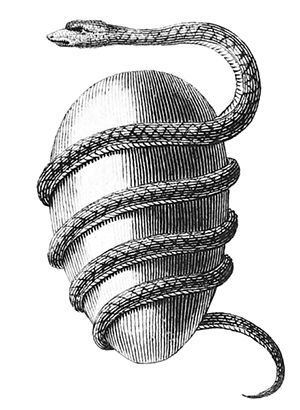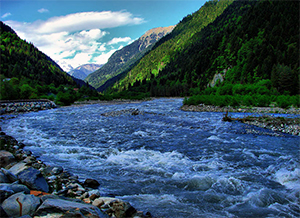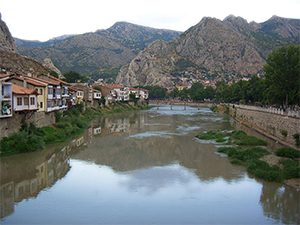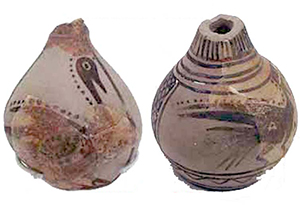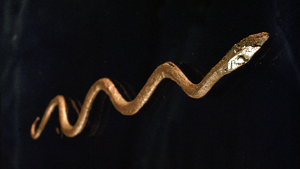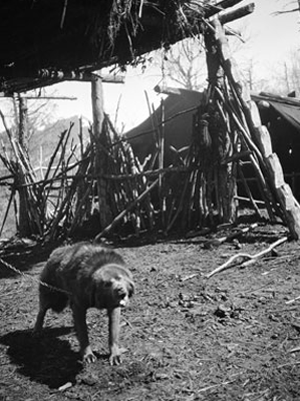The city of Babel, where was the scene of those great occurrences which we have been mentioning, was begun by Nimrod and enlarged by his posterity. It seems to have been a great seminary of idolatry; and the tower, a stupendous building, was erected in honour of the sun, and named the Tower of Bel. Upon the confusion of speech, both the city and tower were called Babel; the original appellation not being obliterated but contained in the latter. And as the city was devoted to the worship of the sun, it was also called the city of Bel-On, five civitas Dei Solis, which was afterwards changed to Babylon. From these terms, I think, we may learn the nature of the judgment inflicted at the time of the dispersion. It did not consist in an utter change of language but, as I have said before, it was a labial failure; an alteration in the mode of speech. It may be called the prevarication of the lip, which had lost all precision, and perverted every sound that was to be expressed. Instead of Bel it pronounced Babel; instead of Bel-on, Babylon; hence Babel, amongst other nations, was used as a term to signify a faulty pronunciation [x]. The Hebrews, says4 [Ant. L. i. c. 4.] Josephus, by the word Babel denote confusion of speech. These terms seem ever afterwards to have been retained, even by the natives, in confirmation of this extraordinary history; and the city, as long as it existed, was called Babylon, or the City of Confusion.
The tower of Babel was probably a rude mound of earth raised to a vast height, and cased with bricks which were formed from the soil of the country, and cemented with asphaltus or bitumen. There are several edifices of this sort still to be seen in the region of Babylonia. They are very like the brick pyramids in Egypt, and between every ninth or tenth row of plinths they have a layer of straw, and sometimes the smaller branches of palm. Travellers have had the curiosity to put in their hands and to extract some of the leaves and straws, which appear wonderfully fresh and perfect, though they have lain there for so many ages. Many have been led to think that one or other of these buildings was the original tower of Babel. But ancient writers are unanimous that it was overthrown, and that Nimrod perished in it. This was the opinion of Syncellus.5 [P. 42.] [x]
But Nimrod would still obstinately stay and reside upon the spot; nor could he by any means be withdrawn from the tower, still having the command over no contemptible body of men. Upon this, we are informed, that the tower being beat upon by violent winds gave way, and by the just judgment of God crushed him to pieces.
Cedrenus also mentions it as a current notion that Nimrod perished in the6 [[x] Cedrenus. p. 11. See Joseph. Ant. L. i. c. 4.] tower. But this, I think, could not be true; for the term of Nimrod's life, extend it to the utmost of Patriarchic age after the flood, could not have sufficed for this. And though writers do assert that the tower was overthrown, and the principal person buried in its ruins -- and it must be confessed that ancient mythology has continual allusions to some such event -- yet I should imagine that this related to the overthrow of the deity there worshiped, and to the extirpation of his rites and religion rather than to any real person. The fable of Vulcan who was thrown down from heaven and cast into the sea is founded upon this story. He was supposed to have been the son of Juno, and detested by his mother, who threw him down with her own hands.
7 [Homer. Hymn to Apollo, v. 317. It related probably to the abolition of fireworship at the destruction of Babel.] [x]
My crippled offspring Vulcan I produced:
But soon I seiz'd the miscreant in my hands,
And hurled him headlong downward to the sea.
Many writers speak of him as being thrown off from the battlements of a high tower by Jupiter; and there is a passage to this purpose in Homer which has embarrassed commentators, though I do not think it very obscure if we consider the history to which it relates.
8 [Iliad. L. A. v. 591.] [x]
The poet, who was a zealous copier of ancient mythology, mentions that Vulcan was cast down by Jupiter from an eminence. He says that he was thrown [x], which must certainly signify [x], or [x], for the sentence is manifestly elliptical.
He seiz'd him by the foot, and headlong threw
From the high tower of Belus.
This is the purport of the passage; and it is consonant to all history.
The Giants, whom Abydenus makes the builders of Babel, are by other writers represented as the Titans. They are said to have received their name from their mother Titaea9 [Diod. Sicul. L. 3. p. 190. [x]. Orphic. Frag. p. 375.] [x] by which we are to understand that they were all denominated from their religion and place of worship. I have taken notice of some of the ancient altars which consisted of a conical hill of earth, styled oftentimes from its figure [x], a mound, or hill, in the shape of a woman's breast. Titaea ([x]) was one of these. It is a term compounded of10 [Tit is analogous to [x], Tid, of the Chaldeans. So Titurus was from Tit-Ur, [x]. The priests so famous for their music were from hence styled Tituri. It was sometimes expressed Tith-Or; hence the summit of Parnassus had the name of Tithorea, being sacred to Orus, the Apollo of Greece. Pausan. L. 10. p. 878. There were places named Titaresus from Tit-Ares, the same as Tit-Orus. [x]. Hesych.] Titaea; and signifies literally a breast of earth, analogous to [x] of the Greeks. These altars were also called Tit-an, and Tit-anis, from the great fountain of light styled An, and Anis. Hence many places were called Titanis and11 [At Sicyon was a place called Titana. Steph. Byzant. also a temple. Pausan. L. 2. p. 138. Euboea called Titanis. Hesych.] Titana, where the worship of the Sun prevailed, for Anes, and Hanes, signified the fountain of light or fire. Titana was sometimes expressed Tithana, by the Ionians rendered Tithena; and as Titaea was supposed to have been the mother of the Titans, so Tithena was said to be their12 [[x]. Hesych. So Tith-On was like Tith-Or, [x]: whence was formed a personage, named Tithonus, beloved by Aurora.] nurse. But they were all uniformly of the same nature, altars raised of soil. That Tith-ana, the supposed nurse, was a sacred mound of earth, is plain from Nonnus, who mentions an altar of this sort in the vicinity of Tyre, and says that it was erected by those earth-born people, the Giants.
13 [Nonni Dionys. L. 40. p. 1048.] [x] 14 [Bel, and Belus, was a title bestowed upon many persons. It was particularly given to Nimrod who built the city Babel, or Babylon. Hence Dorotheus Sidonius, an ancient poet, calls that city the work of Tyrian Belus. [x] This term [x] has been applied to the city Tyre. But [x] here is from [x] Turris, and Belus [x] signifies Belus of Babel, who erected the famous tower. This leads me to suspect that in these verses of Nonnus there is a mistake, and that this Tithena, which the Giants built, was not in the vicinity of the city Tyre, but it was an high altar [x] near the tower of Babel which was erected by the Titanians. Nonnus, imagining that by Tur was meant Tyre, has made the Tithena to be situated [x], by the sea, from which, I believe, it was far removed.] [x]
Upon the coast of Tyre, amid the rocks,
The Giants rais'd an ample mound of earth,
Yclep'd Tithena.
Tuph also in the ancient language was an hill, and Typhoeus is a masculine compound from Tuph-aia, and signifies a mound of earth. Typhon [x] was in like manner a compound of Tuph-On, and was a mount or altar of the same construction and sacred to the sun. I make no doubt but both Typhon and Typhoeus were names by which the tower of Belus was of old denoted. But out of these the mythologies have formed personages, and they represent them as gigantic monsters whom the earth produced in defiance of heaven. Hence Typhon is by Antoninus Liberalis described as,15 [Typhon, Terrae filius. Hyginus. Fab. 152.] [x], the offspring of the earth, a baleful Damon. The tower of Babel was undoubtedly a Tuphon, or altar of the sun, though generally represented as a temple. For in those early times we do not read of any sacred edifices which can be properly called temples, but only of altars, groves, and high places. Hesiod certainly alludes to some ancient history concerning the demolition of Babel when he describes Typhon, or Typhoeus, as overthrown by Jove. He represents him as the youngest son of the Earth.
16 [Theogon. v. 821.] [x]17 [Typhoeus was properly [x], a Pelorian mound of earth, being, as I said above, a masculine from Tuphoea, which is a compound of Tuph-aia, a mound of earth.]
Th' enormous Earth,
Produc'd Typhoeus last of all her brood.
The poet speaks of him as a deity of great strength and immense stature, and says that from his shoulders arose an hundred serpent heads, and that from his eyes there issued a continual blazing fire. And he adds, what is very remarkable, that had it not been for the interposition of the chief God, this Daemon would have obtained an universal empire.
18 [Hesiod. supra. v. 836.] [x]
That day was teeming with a dire event;
And o'er the world Typhoeus now had reign'd
With universal sway: but from on high
Jove view'd his purpose, and opposed his power.
For with a strong and desperate aim he hurl'd
His dread artillery. Then the realms above,
And earth with all its regions; then the sea,
And the Tartarian caverns, dark and drear,
Resounded with his thunder. Heaven was moved,
And the ground trembled underneath his feet,
As the God march'd in terrible array.
Still with fresh vigour Jove renew' d the fight;
And clad in all his bright terrific arms,
With lightnings keen, and smouldering thunderbolts,
Press'd on him fore; till by repeated wounds
The tow'ring monster sunk to endless night.
Typhon was the same personage as Typhoeus; and Antoninus20 [[x]. Fab. 28.] Liberalis describes him as a Giant who was thunderstruck by Jupiter. But he fled to the sea, into which he plunged, and his deadly wounds were healed. The like has been said of Bacchus, that upon his flight he betook himself to the sea. And when Vulcan is cast down from the tower, he is supposed to fall into the same element. Juno is accordingly made to say,
[x]
I seiz'd him in my arms,
And hurl'd him headlong downward to the sea.
Hesiod gives an account of the dispersion of the Titans and of the feuds which preceded, and he says that the Deity at last interposed and put the Titans to flight, and condemned them to reside in Tartarus at the extremities of the earth. The description is very fine, but he has confounded the history by supposing the Giants and Titans to have been different persons. He accordingly makes them oppose one another in battle; and even Cottus, Iapetus, Gyas, whom all writers mention as Titans, are by him introduced in opposition and described as of another family. He sends them indeed to Tartarus, but supposes them to be there placed as a guard over the Titans. His description, however, is much to the purpose, and the first contest and dispersion is plainly alluded to. I shall therefore lay some part of it before the reader.
21 [Theogon. v. 676.] [x]
Firm to their cause the Titans wide display'd
A well-embodied phalanx: and each side
Gave proofs of noble prowess, and great strength,
Worthy of Gods. The tumult reach'd to heaven,
And high Olympus trembled as they strove.
Sea too was mov'd; and Earth astonish'd heard
The noise and shouts of deities engag'd,
High vaunts, loud outcries, and the din of war.
Now Jove no longer could withhold his ire;
But rose with tenfold vengeance: down he hurl'd
His lightning, dreadful implement of wrath,
Which flash'd incessant: and before him mov'd
His awful thunder, with tremendous peal
Appalling, and astounding, as it roll'd.
For from a mighty hand it shap'd its course,
Loud echoing through the vaulted realms of day.
Meantime storms rag'd; and dusky whirlwinds rose.
Still blaz'd the lightning with continual glare,
Till nature languish'd; and th' expanded deep,
And every stream, that lav'd the glowing earth,
Boil'd with redounding heat. A ruddy flame
Shot upwards to the fiery cope of heav'n,
Shedding a baleful influence: and the gleam
Smote dreadful on the Titan bands, whose eyes
Were blasted, as they gaz'd; nor could they stand
The fervour, but exhausted sunk to ground.
The Gods, victorious, seiz'd the rebel crew,
And sent them, bound in adamantine chains,
To earth's deep caverns, and the shades of night.
Here dwell th' apostate brotherhood, consign'd
To everlasting durance: here they sit
Age after age in melancholy state,
Still pining in eternal gloom, and lost
To every comfort. Round them wide extend
The dreary bounds of earth, and sea, and air,
Of heaven above, and Tartarus below.
Such was the first great commotion among men. It was described by the poets as the war of the Giants, who raised mountains upon mountains in order that they might scale heaven. The sons of Chus were the aggressors in these acts of rebellion. They have been represented under the character both of Giants and Titanians: and are said to have been dissipated into different parts of the world.
[T]he astral prototypes of the lower beings of the animal kingdom of the Fourth Round, which preceded (the chhayas of) Men, were the consolidated, though still very ethereal sheaths of the still more ethereal forms or models produced at the close of the Third Round on Globe D. [215] “Produced from the residue of the substance matter; from dead bodies of men and (other extinct) animals of the wheel before,” or the previous Third Round — as Stanza 24 tells us. Hence, while the nondescript “animals” that preceded the astral man at the beginning of this life-cycle on our Earth were still, so to speak, the progeny of the man of the Third Round, the mammalians of this Round owe their existence, in a great measure, to man again. Moreover, the “ancestor” of the present anthropoid animal, the ape, is the direct production of the yet mindless Man, who desecrated his human dignity by putting himself physically on the level of an animal….
Ay, but that “primeval man” was man only in external form. He was mindless and soulless at the time he begot, with a female animal monster, the forefather of a series of apes….
Perchance in these specimens, Haeckelians might recognize, not the Homo primigenius, but some of the lower tribes, such as some tribes of the Australian savages. Nevertheless, even these are not descended from the anthropoid apes, but from human fathers and semi-human mothers, or, to speak more correctly, from human monsters — those “failures” mentioned in the first Commentary. The real anthropoids, Haeckel’s Catarrhini and Platyrrhini, came far later, in the closing times of Atlantis. The orang-outang, the gorilla, the chimpanzee and cynocephalus are the latest and purely physical evolutions from lower anthropoid mammalians. They have a spark of the purely human essence in them; man on the other hand, has not one drop of pithecoid blood in his veins.….
These “Men” of the Third Race — the ancestors of the Atlanteans — were just such ape-like, intellectually senseless giants as were those beings, who, during the Third Round, represented Humanity. Morally irresponsible, it was these third Race “men” who, through promiscuous connection with animal species lower than themselves, created that missing link which became ages later (in the tertiary period only) the remote ancestor of the real ape as we find it now in the pithecoid family. [150]...
A naturalist suggests another difficulty. The human is the only species which, however unequal in its races, can breed together. “There is no question of selection between human races,” say the anti-Darwinists, and no evolutionist can deny the argument — one which very triumphantly proves specific unity. How then can Occultism insist that a portion of the Fourth Race humanity begot young ones from females of another, only semi-human, if not quite an animal, race, the hybrids resulting from which union not only bred freely but produced the ancestors of the modern anthropoid apes? Esoteric science replies to this that it was in the very beginnings of physical man. Since then, Nature has changed her ways, and sterility is the only result of the crime of man’s bestiality….
But this was when Africa had already been raised as a continent. We have meanwhile to follow, as closely as limited space will permit, the gradual evolution of the now truly human species. It is in the suddenly arrested evolution of certain sub-races, and their forced and violent diversion into the purely animal line by artificial cross-breeding, truly analogous to the hybridization, which we have now learned to utilize in the vegetable and animal kingdoms, that we have to look for the origin of the anthropoids. In these red-haired and hair-covered monsters, the fruit of the unnatural connection between men and animals, the “Lords of Wisdom” did not incarnate, as we see. Thus by a long series of transformations due to unnatural cross-breeding (unnatural “sexual selection”), originated in due course of time the lowest specimens of humanity; while further bestiality and the fruit of their first animal efforts of reproduction begat a species which developed into mammalian apes ages later....
For surely, it was not in or through the wickedness of the “mighty men” . . . . men of renown, among whom is placed Nimrod the “mighty hunter before the Lord,” that “god saw that the wickedness of man was great,” nor in the builders of Babel, for this was after the Deluge; but in the progeny of the giants who produced monstra quaedam de genere giganteo, monsters from whence sprang the lower races of men, now represented on earth by a few miserable dying-out tribes and the huge anthropoid apes….
The monsters bred in sin and shame by the Atlantean giants, “blurred copies” of their bestial sires, and hence of modern man (Huxley), now mislead and overwhelm with error the speculative Anthropologist of European Science…
[T]he bestiality of the primeval mindless races resulted in the production of huge man-like monsters — the offspring of human and animal parents. As time rolled on, and the still semi-astral forms consolidated into the physical, the descendants of these creatures were modified by external conditions, until the breed, dwindling in size, culminated in the lower apes of the Miocene period. With these the later Atlanteans renewed the sin of the “Mindless” — this time with full responsibility. The resultants of their crime were the species of apes now known as Anthropoid…
On the data furnished by modern science, physiology, and natural selection, and without resorting to any miraculous creation, two negro human specimens of the lowest intelligence — say idiots born dumb — might by breeding produce a dumb Pastrana species, which would start a new modified race, and thus produce in the course of geological time the regular anthropoid ape….
-- The Secret Doctrine: The Synthesis of Science, Religion, and Philosophy, by Helena P. Blavatsky
One place of their retreat is mentioned to have been in that part of Scythia which bordered upon the Palus Maeotis.
River Don in Voronezh Oblast, Russia
The Maeotian Swamp or Maeotian Marshes was a name applied in antiquity variously to the swamps at the mouth of the Tanais River in Scythia (the modern Don in southern Russia) and to the entire Sea of Azov which it forms there. The sea was also known as the Maeotian Lake among other names. The people who lived around the sea were known as the Maeotians, although it remains unclear which was named for which.
The Ixomates were a tribe of the Maeotes. To the south of the Maeotes, east of the Crimea were the Sindes, their lands known as Scythia Sindica.
The marshes served to check the westward migration of nomad peoples from the steppe of Central Asia. The Iazyges, a Sarmatian tribe, were first heard of on the Maeotis, where they were among the allies of Mithridates II of Parthia. The untrustworthy 4th-century Historia Augusta claims the Roman emperor Marcus Claudius Tacitus secured a victory over the Alans near the marshes during his brief reign in 275 and 276.
-- Maeotian Swamp, by Wikipedia
It was called22 [[x]. Dion. Cassius. L. 51. p. 313.] Keira, and described as a vast cavern which they fortified. The Romans under Crassus are said to have viewed it. But Keir, and Keirah, signified of old a city or fortress; and it was the appellative name of the place to which this people retired. They were to be found in various parts as I shall shew; but the most prevailing notion about the Titanians was that after their war against heaven they were banished to Tartarus at the extremities of the earth. The ancient Grecians knew very little of the western parts of the world. They therefore represent the Titans as in a state of darkness, and Tartarus as an infernal region.
23 [Hesiod. Theog. v. 717.] [x]
They plac'd the rebels, fast in fetters bound,
Deep in a gloomy gulf; as far remov'd
From earth's fair regions, as the earth from heaven.
They are the words of Hesiod, who says that an anvil of iron being dropped down would but just reach the abyss in ten days. Here the Titans were doomed to reside.
24 [Ibid. v. 729.] [x].
There the Titanian Gods by Jove's high will
In mansions dark and dreary lie concealed,
Beyond the verge of nature. Cottus here,
And Gyges dwell, and Briareus the bold.
These were part of the Titanian brood, though the author seems not to allow it. This will appear from some of the Orphic fragments, where we have the names of the Titans and a similar account of their being condemned to darkness.
25 [Orphic. Frag. p. 374.] [x].
The poet here specifies seven in number: Coeus, Crius, Phorcys, Cronus, Oceanus, Hyperion, and Iapetus, and he adds,
[x]
Soon as high Jove their cruel purpose saw,
And lawless disposition--
He sent them down to Tartarus consign'd.
If we look into the grounds of these fictions, we shall find that they took their rise from this true history. A large body of Titanians, after the dispersion, settled in Mauritania, which is the region styled Tartarus.
In Greek mythology, Atlas is a Titan condemned to hold up the heavens or sky for eternity after the Titanomachy. Atlas also plays a role in the myths of two of the greatest Greek heroes: Heracles (Hercules in Roman mythology) and Perseus. According to the ancient Greek poet Hesiod, Atlas stood at the ends of the earth in extreme west. Later, he became commonly identified with the Atlas Mountains in northwest Africa and was said to be the first King of Mauretania.Mauretania is the Latin name for a region in the ancient Maghreb. It stretched from central present-day Algeria westwards to the Atlantic, covering northern Morocco, and southward to the Atlas Mountains. Its native inhabitants, seminomadic pastoralists of Berber ancestry, were known to the Romans as the Mauri and the Masaesyli.
In 25 BC, the kings of Mauretania became Roman vassals until about 44 AD, when the area was annexed to Rome and divided into two provinces: Mauretania Tingitana and Mauretania Caesariensis. Christianity spread there from the 3rd century onwards. After the Muslim Arabs subdued the region in the 7th century, Islam became the dominant religion.
-- Mauretania, by Wikipedia
Atlas was said to have been skilled in philosophy, mathematics, and astronomy. In antiquity, he was credited with inventing the first celestial sphere. In some texts, he is even credited with the invention of astronomy itself.
Atlas was the son of the Titan Iapetus and the Oceanid Asia or Clymene. He was a brother of Epimetheus and Prometheus. He had many children, mostly daughters, the Hesperides, the Hyades, the Pleiades, and the nymph Calypso who lived on the island Ogygia....
The "Atlantic Ocean" is derived from "Sea of Atlas". The name of Atlantis mentioned in Plato's Timaeus' dialogue derives from "Atlantis nesos", literally meaning "Atlas's Island."...
Atlas and his brother Menoetius sided with the Titans in their war against the Olympians, the Titanomachy. When the Titans were defeated, many of them (including Menoetius) were confined to Tartarus, but Zeus condemned Atlas to stand at the western edge of the earth and hold up the sky on his shoulders. Thus, he was Atlas Telamon, "enduring Atlas," and became a doublet of Coeus, the embodiment of the celestial axis around which the heavens revolve.
A common misconception today is that Atlas was forced to hold the Earth on his shoulders, but Classical art shows Atlas holding the celestial spheres, not the terrestrial globe.
-- Atlas (mythology), by Wikipedia
Diodorus Siculus mentions the coming of Cronus into these parts, and gives us the names of the brotherhood, those sons of Titaea, who came with them. The principal of these, exclusive of Cronus, were26 [Diodor. Sic. L. 5. p. 934. According to Apollodorus their names were Ouranus, Coeus, Hyperion, Crius, Iapetus, and the youngest of all Cronus. L. i. p. 2.] Oceanus, Coeus, Iapetus, Crius, and Hyperion; who were supposed first to have settled in Crete. Atlas was another of them from whom they had the name of27 [Diodor. L. 3. p. 189.] Atlantians; and they were looked upon as the offspring of heaven. The above historian describes the country which they possessed as lying upon the great ocean; and however it may be represented by the poets, he speaks of it as a happy28 [[x]. Ibid.] region. The mythologists adjudged the Titans to the realms of night, and consequently to a most uncomfortable climate, merely from not attending to the purport of the term [x].
[x]
It is to be observed that this word had two significations. First it denoted the west, or place of the setting sun. Hence Ulysses, being in a state of uncertainty, says29 [Odyss. K. v. 190.] [x]. We cannot determine, which is the west, or which is the east. It signified also darkness, and from this secondary acceptation the Titans of the west were consigned to the realms of night, being situated in respect to Greece towards the regions of the setting sun. The vast unfathomable abyss, spoken of by the poets, is the great Atlantic Ocean, upon the borders of which Homer places the gloomy mansions where the Titans resided. The ancients had a notion that the earth was a widely-extended plain, which terminated abruptly in a vast cliff of immeasurable descent. At the bottom was a chaotic pool, or ocean, which was so far sunk beneath the confines of the world that to express the depth and distance, they imagined an anvil of iron tossed from the top would not reach it under ten days. But this mighty pool was the ocean abovementioned; and these extreme parts of the earth were Mauritania and Iberia, for in each of these countries the Titans resided. Hence, Callimachus, speaking of the latter country, describes the natives under the title of 30 [[x]. Heysch. [x]. Ibid. [x]. Hymn, in Delon. v. 174.] [x], by which is meant the offspring of the ancient Titans. They were people of the Cuthite race, who also took up their habitation in Mauritania, and were represented as the children of Atlas.
The Samaritans are members of an ethnoreligious group originating from the Israelites. They are native to the Levant and adhere to Samaritanism, an Abrahamic, monotheistic and ethnic religion in the Holy Land.In its narrowest sense, which is in use today in archaeology and other cultural contexts, it is equivalent to a stretch of land bordering the Mediterranean in southwestern Asia, i.e. the historical region of Syria ("greater Syria"), which includes present-day Syria, Lebanon, Jordan, Israel, Palestine and most of Turkey southwest of the middle Euphrates. Its overwhelming characteristic is that it represents the land bridge between Africa and Eurasia. In its widest historical sense, the Levant included all of the Eastern Mediterranean with its islands; that is, it included all of the countries along the Eastern Mediterranean shores, extending from Greece to Cyrenaica in eastern Libya.
The term entered English in the late 15th century from French. It derives from the Italian Levante, meaning "rising", implying the rising of the Sun in the east, and is broadly equivalent to the term al-Mashriq meaning "the eastern place, where the Sun rises".
-- Levant, by Wikipedia
Samaritans believe that their religion is based exclusively on the five books of Moses given to the Israelites on Mount Sinai. The Samaritan Torah contains some differences from the Jewish Torah or Masoretic Text; according to Samaritan tradition, key parts of the Jewish text were fabricated by Ezra. The Samaritan version of the book of Joshua differs from the version in Jewish Scripture which focuses on Shiloh. According to Samaritan tradition, Joshua built a temple (al-haikal) and placed therein a tabernacle (al-maškan) in the second year of the Israelites' entry into the land of Canaan. Samaritans believe that Samaritanism is the true religion of the ancient Israelites, preserved by those who remained in the Land of Israel during the Babylonian captivity; this belief is held in opposition to Judaism, the ethnic religion of the Jewish people, which Samaritans see as a closely-related but altered and amended religion brought back by those returning from captivity in Babylon under the Neo-Babylonian Empire.
The Samaritan people believe that Mount Gerizim, located near the city of Nablus in the vicinity of the Biblical Shechem in the modern-day West Bank, is the original holiest place for the Israelites since the time of Creation, the Patriarchs, the Mosaic Covenant and Joshua's conquest, before the establishment of Jerusalem's Temple under the Davidic and Solomonic rule, and it is commonly taught in Samaritan tradition that there are 13 references to Mount Gerizim in the Torah (Pentateuch) to prove their claim, in contrast to Judaism which relies solely on the later Jewish prophets and writings to back their claims of the holiness of Jerusalem. Consequently, their views differ from Jewish belief regarding the holiest site on Earth to worship God, designated by Judaism to be the Temple Mount in Jerusalem, but by Samaritanism to be Mount Gerizim near Nablus....
Presently, the total population of the Samaritans stands at less than 1,000 people, divided into two communities: one in Nablus in the Samaritan village of Kiryat Luza on the ridge of Mount Gerizim, and one in Holon in the Samaritan quarter of 15a Ben Amram Street. The Samaritans residing in Kiryat Luza hold both Israeli citizenship and Palestinian citizenship. Samaritans in Holon primarily speak Israeli Hebrew, while those in Kiryat Luza speak Levantine Arabic; for liturgical purposes, Samaritan Hebrew and Samaritan Aramaic are used, written in the Samaritan script.
Samaritans have a standalone religious status in Israel, and there are occasional conversions from Judaism to Samaritanism and vice-versa, largely due to interfaith marriages. While Israel's rabbinic authorities consider Samaritanism to be a sect of Judaism, the Chief Rabbinate of Israel requires Samaritans to undergo a formal conversion to Judaism in order to be officially recognized as Halakhic Jews. Rabbinic literature rejected Samaritans unless they renounced Mt Gerizim. Samaritans possessing only Israeli citizenship are drafted into the Israel Defense Forces, while those holding dual Israeli and Palestinian citizenship in Kiryat Luza are exempted from mandatory military service....
In the Talmud, a central post-exilic religious text of Rabbinic Judaism, the Samaritans are called Cuthites or Cutheans, referring to the ancient city of Kutha, geographically located in what is today Iraq. Josephus's Wars of the Jews also refers to the Samaritans as the Cuthites. In the biblical account, however, Kuthah was one of several cities from which people were brought to Samaria, and they worshiped Nergal.Samaria is the ancient, historic, biblical name used for the central region of the Land of Israel, bordered by Judea to the south and Galilee to the north. The first-century historian Josephus set the Mediterranean Sea as its limit to the west, and the Jordan River as its limit to the east. Its territory largely corresponds to the biblical allotments of the tribe of Ephraim and the western half of Manasseh; after the death of Solomon and the splitting-up of his empire into the southern Kingdom of Judah and the northern Kingdom of Israel, this territory constituted the southern part of the Kingdom of Israel. The border between Samaria and Judea is set at the latitude of Ramallah.
The name "Samaria" is derived from the ancient city of Samaria, capital of the northern Kingdom of Israel. The name Samaria likely began being used for the entire kingdom not long after the town of Samaria had become Israel's capital, but it is first documented after its conquest by Sargon II [722–705 BC] of Assyria, who turned the kingdom into the province of Samerina.
-- Samaria, by Wikipedia
Modern genetics partially support both the claims of the Samaritans and the account in the Hebrew Bible (and Talmud), suggesting that the genealogy of the Samaritans lies in some combination of these two accounts. This suggests that the Samaritans remained a genetically isolated population.
-- Samaritans, by Wikipedia
He was described as the son of Iapetus the Titan, and of so vast a stature as to be able to support the heavens.
31 [Hesiod. Theog. v. 746. [x]. Ibid. V. 517.] [x].
There Atlas, son of great Iapetus,
With head inclin'd, and ever-during arms,
Sustains the spacious heavens.
To this Atlantic region the Titans were banished, and supposed to live in a state of darkness beyond the limits of the known world.
32 [Ibid. v. 813.] [x].
Farthest remov'd
Of all their kindred Gods the Titans dwell,
Beyond the realms of chaos dark.
By [x] we must certainly understand the western ocean, upon the borders of which, and not beyond it, these Titanians dwelt. By the Nubian Geographer the Atlantic is uniformly called according to the present version Mare Tenebrarum.33 [Geog. Nubiensis. p. 4. p. 6. and p. 156.] Aggressi sunt mare tenebrarum, quid in eo esset, exploraturi. They ventured into the sea of darkness, in order to explore what it might contain. Another name for Tartarus, to which the poets condemned the Titans and Giants, was Erebus. This, like [x], was a term of twofold meaning. For Ereb [x] signified both the west and also darkness, and this served to confirm the notion that the Titans were consigned to the regions of night. But gloomy as the country is described, and horrid, we may be assured from the authorities of34 [[x]. L. 3. p. 189.] Diodorus and Pliny, that it was quite the reverse; and we have reason to think that it was much resorted to; and that the natives for a long time kept up a correspondence with other branches of their family. Homer affords some authority for this opinion in a passage where he represents Jupiter as accosting Juno, who is greatly displeased.
In "A Descent Into the Malestrom," before the old mariner's confrontation with the whirlpool, the uninitiated narrator remarks on the prospect: "I looked dizzily, and beheld a wide expanse of ocean, whose waters were so inky a hue as to bring to mind the Nubian geographer's account of the Mare Tenebrarum."1 [The Complete Works of Edgar Allan Poe, ed. James A. Harrison (New York, 1902/1965), II, 226-227. All other references to this edition will be noted in the text by volume and page number.] In Burton Pollin's Dictionary of Names and Titles in Poe's Collected Works, the identity of this geographical authority is left open to question. Hanna, Claudius Ptolemy, and Idrisi have been mentioned as possibilities.2 [Pollin mentions Idrisi and Claudius Ptolemy in Dictionary (New York, 1968), p. 68. Admitting uncertainty, T.O. Mabbott mentions Hanno and Idresi in Selected Poetry and Prose of Edgar Allan Poe (New York, 1951), p. 421.] The allusion is of more than trifling importance, since Poe recast it in "Eleonora," the preface to "Mellonta Tauta," and Eureka. These four references indicate a singular fascination with the geographer and his descriptive account. In each case, Poe's source was Jacob Bryant's A New System; or, An Analysis of Ancient Mythology (1807).3 [London, 1807.] The treatment of the Nubian geographer in Bryant's work clarifies a significant allusion, invites a re-evaluation of the sources of "A Descent into the Maelstrom," and adds to an understanding of the image patterns in the tale.
While the sources of "A Descent into the Maelstrom" have received fairly rigorous attention4 [See Adolph B. Benson, "Scandinavian References in the Works of Edgar Allan Poe," Journal of English and Germanic Philology, XL (Jan., 1941), 73-90; Arlin Turner, "Sources of Poe's 'A Descent into the Maelstrom,'" Journal of English and Germanic Philology, XLVI (July, 1947), 298-301; William T. Bandy, "New Light on a Source of Poe's 'A Descent into the Maelstrom,'" American Literature, XXIV (Jan, 1953), 534-537; Margaret J. Yonce, "The Spiritual Descent into the Maelstrom: A Debt to "The Rime of the Ancient Mariner,'" Poe Newsletter, II (April, 1969), 26-29; and Carroll D. Laverty, "Science and Pseudo-Science in the Writings of Edgar Allan Poe" (Unpublished dissertation, Duke University, 1951), pp. 178-179.] allowance must be made for Bryant's in-
-- Notes: Poe's Nubian Geographer, by Kent Ljungquist, Bluefield College, American Literature, Vol. 48, No. 1 (Mar., 1976), pp. 73-75 (3 pages), Published By: Duke University Press
35 [Iliad. O. v. 477.] [x].
I shall not, says Jupiter, regard your resentment; not though you should desert me, and betake yourself to the extremities of the earth, to the boundaries of sea and land [x]; to the lower limits, where Iapetus and Cronus reside, who never enjoy the light of the sun, nor are refreshed with cooling breezes, but are seated in the depths of Tartarus. In the Ion of Euripides, Creusa, being in great distress, wishes that she could fly away to the people of the western world, which she alludes to as a place of security.
36 [Euripid. Ion. v. 796.] [x].
O! that I could be wafted through the yielding air,
Far, very far, from Hellas,
To the inhabitants of the Hesperian region:
So great is my load of grief.
From the words of Jupiter above, who tells Juno that she may retire to the regions in the west; and from these of Creusa, who longs to betake herself to the same parts; we may infer that in the first ages it was not uncommon for people in distress to retire to these settlements. Probably famine, sickness, and oppression, as well as the inroads of a powerful enemy, might oblige the Ionim to migrate. And however the Atlantic Titanians may have been like the Cimmerians, described as a people devoted to darkness, yet we find them otherwise represented by Creusa, who styles them [x], the stars of the western world. They were so denominated from being the offspring of the original Ionim, or Peleiadae, of Babylonia, in memory of whom there was a constellation formed in the heavens. These Peleiadas are generally supposed to have been the daughters of Atlas, and by their names the stars in this constellation are distinguished. Diodorus Siculus has given us a list of them, and adds that from them the most celebrated37 [Diodor. Sic. L. 3. p. 194.] heroes were descended. The Helladians were particularly of this family; and their religion and Gods were of Titanian38 [[x]. Scholia in Pind. Nem. Od. 6. v. i. [x]. Orphic. Hymn. 36. Pindar says that the Titans were at last freed from their bondage. [x]. Pyth. Od. 4. v. 518.] original.[!!!]
Helladian, Adjective, rare: Of or relating to Greece, especially ancient Greece; Hellenic.
Origin: Late 18th century; earliest use found in Jacob Bryant (bap. 1717, d. 1804), antiquary and classical scholar. From ancient Greek Ἑλλαδ-, Ἑλλάς Greece (goes to classical Latin Hellad-, Hellas; in form a feminine adjective (short for Ἑλλάς γῆ the Helladic land) from the base of Ἕλλην + -άς) + -ian.
-- Helladian, by Oxford Lexico
EAST TO WEST MEANS PAST TO FUTURE
1976 1859 1529 1A.D. 4200 B.C.
THE GENETIC RUNWAY
Once past the Obstetrical Arrival gate, Feel Free to Use (or abuse) your Head To Create the Realities you are equipped to choose.
But ...
Please don't Clutter Up
THE GENETIC RUNWAY
-- The Intelligence Agents, by Timothy Leary, Ph.D., © 1979 by Timothy Leary, Ph.D.



